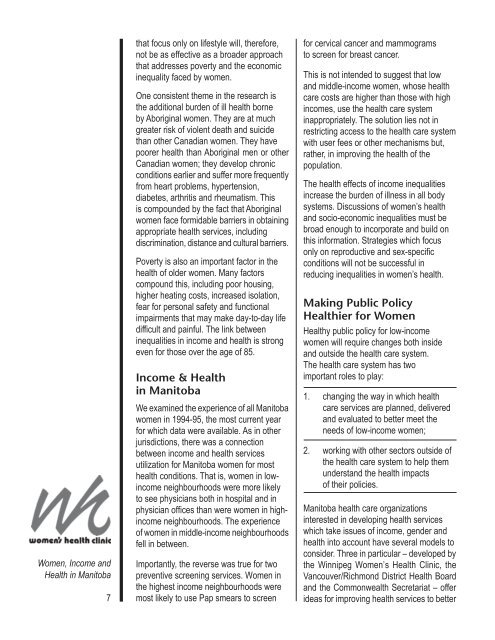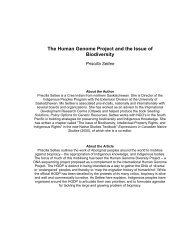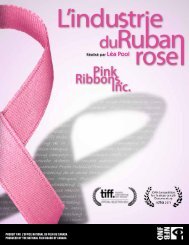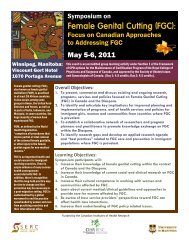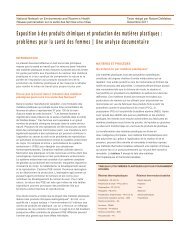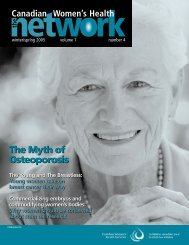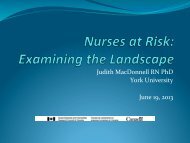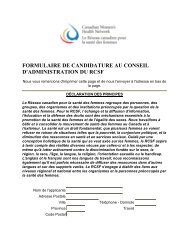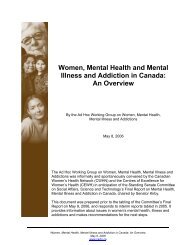Women, Income and<strong>Health</strong> in Manitoba6■■In 1996, 31.8% of visible minoritywomen in Manitoba lived in poverty. 8Yet, they are more likely than other<strong>Canadian</strong> women to be employedfull-time. 9Recent immigrant women haveparticularly low incomes. In 1995,their average income for all ofCanada was only $12,000, about62% of the amount earned by<strong>Canadian</strong>-born women that year. 10These disparities are becoming worse, notbetter. A recent report for the Centre forSocial Justice noted that:Not only are t<strong>here</strong> more families in thelowest income category but they havealso become poorer over time: tobelong to the poorest 10 per cent ofthe population meant earning less than$11,567 in 1989. By 1997, it meantearning less than $6,591. 11Income and <strong>Health</strong>T<strong>here</strong> are many studies showing theconnection between income and health.As the Manitoba researcher PatriciaKaufert, Ph.D has observed:locating health in the social conditionsof people’s lives is an idea which canbe dated back to the origins of thepublic health movement. 12Research shows that medical care is lessimportant in ensuring the well-being of theentire population than economic security,social support and a more equitabledistribution of income. The connectionbetween poverty and poor health hascontinued to exist even as medicinehas progressed, persisting despite t<strong>here</strong>duction in mortality and improvementsin other measures of health.Inequalities in health are not only aproblem for poor <strong>Canadian</strong>s. Data fromManitoba is consistent with data from othercountries. <strong>Health</strong> status worsens at everystep down the socio-economic ladder. Poorpeople may be more at risk, but everybodyis affected.Economic inequality itselfis a health risk.Studies suggest that the distributionof income in a given society may be amore important determinant of healththan the total amount of income earnedby society members. Large gaps inincome distribution lead to increasesin social problems and poorer healthamong the population as a whole. 13What the Research Tells UsT<strong>here</strong> is a substantial body of researchlinking women’s household incomes andtheir health. While past research has foundthe connection to be weaker for womenthan for men, recent <strong>Canadian</strong> researchshows the reverse. 14 This research alsosuggests that socio-economic status andother factors beyond individual control(such as family structure, age and socialsupport) are more important to women’shealth status than lifestyle factors suchas smoking, alcohol consumption andphysical activity. Women’s health services8Statistics Canada, 1996 Census, Dimension Series,#94F009XDB960039Statistics Canada, Women in Canada 2000, page 22710ibid, page 20411Yalnizyan, A., Canada’s Great Divide: The politics of thegrowing gap between rich and poor in the 1990s, Toronto:Centre for Social Justice, 2000, page ii12Kaufert, Patricia “The Vanishing Woman: Gender andPopulation <strong>Health</strong>”, from Sex, Gender and <strong>Health</strong>, forthcoming,Cambridge University Press, 1999, page 12113Federal, Provincial and Territorial Advisory Committee onPopulation <strong>Health</strong>, Toward a <strong>Health</strong>y Future: Second Report onthe <strong>Health</strong> of <strong>Canadian</strong>s, 1999, page ix14Denton, Margaret and Walters, Vivienne “Gender differencesin structural and behavioral determinants of health: an analysis ofthe social production of health”, Social Science and Medicine, 48(1999), page 1232
Women, Income and<strong>Health</strong> in Manitoba7that focus only on lifestyle will, t<strong>here</strong>fore,not be as effective as a broader approachthat addresses poverty and the economicinequality faced by women.One consistent theme in the research isthe additional burden of ill health borneby Aboriginal women. They are at muchgreater risk of violent death and suicidethan other <strong>Canadian</strong> women. They havepoorer health than Aboriginal men or other<strong>Canadian</strong> women; they develop chronicconditions earlier and suffer more frequentlyfrom heart problems, hypertension,diabetes, arthritis and rheumatism. Thisis compounded by the fact that Aboriginalwomen face formidable barriers in obtainingappropriate health services, includingdiscrimination, distance and cultural barriers.Poverty is also an important factor in thehealth of older women. Many factorscompound this, including poor housing,higher heating costs, increased isolation,fear for personal safety and functionalimpairments that may make day-to-day lifedifficult and painful. The link betweeninequalities in income and health is strongeven for those over the age of 85.Income & <strong>Health</strong>in ManitobaWe examined the experience of all Manitobawomen in 1994-95, the most current yearfor which data were available. As in otherjurisdictions, t<strong>here</strong> was a connectionbetween income and health servicesutilization for Manitoba women for mosthealth conditions. That is, women in lowincomeneighbourhoods were more likelyto see physicians both in hospital and inphysician offices than were women in highincomeneighbourhoods. The experienceof women in middle-income neighbourhoodsfell in between.Importantly, the reverse was true for twopreventive screening services. Women inthe highest income neighbourhoods weremost likely to use Pap smears to screenfor cervical cancer and mammogramsto screen for breast cancer.This is not intended to suggest that lowand middle-income women, whose healthcare costs are higher than those with highincomes, use the health care systeminappropriately. The solution lies not inrestricting access to the health care systemwith user fees or other mechanisms but,rather, in improving the health of thepopulation.The health effects of income inequalitiesincrease the burden of illness in all bodysystems. Discussions of women’s healthand socio-economic inequalities must bebroad enough to incorporate and build onthis information. Strategies which focusonly on reproductive and sex-specificconditions will not be successful inreducing inequalities in women’s health.Making Public Policy<strong>Health</strong>ier for Women<strong>Health</strong>y public policy for low-incomewomen will require changes both insideand outside the health care system.The health care system has twoimportant roles to play:1. changing the way in which healthcare services are planned, deliveredand evaluated to better meet theneeds of low-income women;2. working with other sectors outside ofthe health care system to help themunderstand the health impactsof their policies.Manitoba health care organizationsinterested in developing health serviceswhich take issues of income, gender andhealth into account have several models toconsider. Three in particular – developed bythe Winnipeg Women’s <strong>Health</strong> Clinic, theVancouver/Richmond District <strong>Health</strong> Boardand the Commonwealth Secretariat – offerideas for improving health services to better
- Page 1 and 2: WOMEN, INCOME ANDHEALTH IN MANITOBA
- Page 3 and 4: TABLE OF CONTENTSPageA. EXECUTIVE S
- Page 5: EXECUTIVE SUMMARYTHE LINK between p
- Page 9 and 10: B. INTRODUCTIONMuch work has been d
- Page 11 and 12: Consistent with the majority of soc
- Page 13 and 14: Health and Well-Being of Children i
- Page 15 and 16: Women, Income andHealth in Manitoba
- Page 17 and 18: members of different visible minori
- Page 19 and 20: Women, Income andHealth in Manitoba
- Page 21 and 22: 3. How has the connection between i
- Page 23 and 24: E. INCOME AND THE HEALTH OF WOMEN -
- Page 25 and 26: Women, Income andHealth in Manitoba
- Page 27 and 28: majority of British households,rega
- Page 29 and 30: Women, Income andHealth in Manitoba
- Page 31 and 32: The following chart, based on a cha
- Page 33 and 34: marsh potatoes, berries, etc. As a
- Page 35 and 36: opportunities for women may beone o
- Page 37 and 38: 2. Manitoba Data - Income and Healt
- Page 39 and 40: CHART 3HEALTH CARE EXPENDITURES ON
- Page 41 and 42: 3. What Does This Mean?As in other
- Page 43 and 44: procedures. It is noteworthy that t
- Page 45 and 46: 2. The Commonwealth Secretariat -Mo
- Page 47 and 48: Women, Income andHealth in Manitoba
- Page 49 and 50: H. MAKING PUBLIC POLICY HEALTHIER F
- Page 51 and 52: against women and its consequences
- Page 53 and 54: 3.3 CHILD TAX BENEFITThe Government
- Page 55 and 56: Household Basic Rent Rent Including
- Page 57 and 58:
If RHAs are open to suchcollaborati
- Page 59 and 60:
APPENDIX 1:SUGGESTIONS FOR FUTURE R
- Page 61 and 62:
Women, Income andHealth in Manitoba
- Page 63 and 64:
APPENDIX 3:HEALTH SERVICE UTILIZATI
- Page 65 and 66:
APPENDIX 4:INTERVIEWS WITH ABORIGIN
- Page 67 and 68:
Women, Income andHealth in Manitoba
- Page 69 and 70:
Women, Income andHealth in Manitoba
- Page 71 and 72:
Women, Income andHealth in Manitoba
- Page 73 and 74:
ELEMENT #11GENDER SENSITIVE TRAININ
- Page 75 and 76:
Women, Income andHealth in Manitoba
- Page 77 and 78:
ENDNOTES1. Sarlo, Christopher, “P
- Page 79 and 80:
ENDNOTES (continued)45. Arber, Sara
- Page 81 and 82:
ENDNOTES (continued)88. Mustard, Ca
- Page 83 and 84:
REFERENCES (continued)Clarke, H.F.
- Page 85 and 86:
REFERENCES (continued)Macintyre, Sa
- Page 87 and 88:
REFERENCES (continued)Vancouver/Ric


